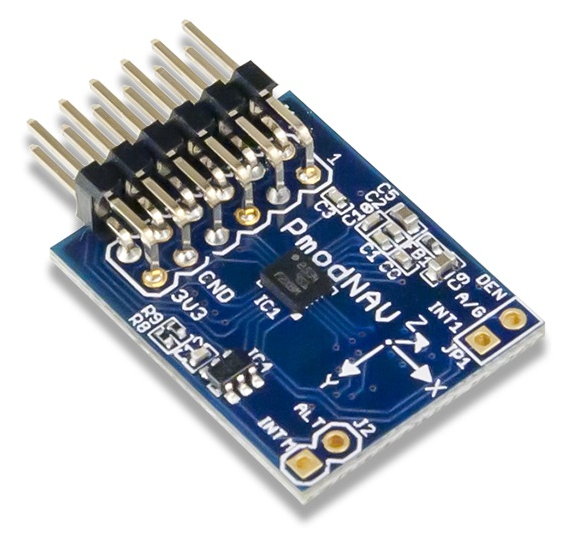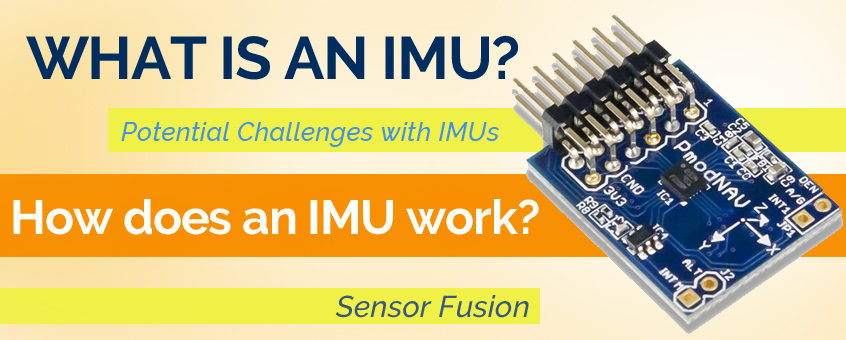At Studica, we have a lot of experience working with robotics and hardware. For those of you who are interested in these topics, you’ve probably come across something called an “IMU”. You may have found yourself wondering what an IMU is. For starters, IMU is an acronym for the Inertial Measurement Unit. These devices are found in all sorts of realms; aerospace, robotics, rocketry and more. In this post, we’ll give a brief description of what IMU’s are used for, how they work, and some potential challenges you should be aware of.
What is an IMU used for?
 Essentially, an IMU reports data related to orientation, velocity, and gravity, depending on which sensors are involved. This data is important for maneuvering vehicles or aircraft or simply for tracking this data for some other purpose. For instance, unmanned aircraft, such as drones, utilize IMU for reporting data to the operator or for automating certain maneuvering functionality with the assistance of a computer. A traveling robot may use an IMU to track its orientation and velocity at any given time.
Essentially, an IMU reports data related to orientation, velocity, and gravity, depending on which sensors are involved. This data is important for maneuvering vehicles or aircraft or simply for tracking this data for some other purpose. For instance, unmanned aircraft, such as drones, utilize IMU for reporting data to the operator or for automating certain maneuvering functionality with the assistance of a computer. A traveling robot may use an IMU to track its orientation and velocity at any given time.
Even modern smartphones often have IMUs, so app developers can make use of their sensors and use data about the phone’s orientation relative to the Earth, for instance. Pedometers make use of IMUs to track the number of steps people take. An IMU can also help approximate distances traveled and where magnetic North is. Basically, IMUs are an increasingly common piece of hardware that facilitate a lot of functionality when paired with a computer that can run computations on the data the IMU sends.
How does an IMU work?
Most IMUs that you’ll find on the market consist of an accelerometer, a gyroscope, and a magnetometer. Such IMUs are said to have 9 DOF (degrees of freedom). Degrees of freedom in the context of an IMU basically refers to the fact that the IMU will report 9 different values.
 The accelerometer reports the acceleration force on the X, Y, and Z axis of the IMU. The gyroscope reports angular acceleration around the X, Y, and Z axis of the IMU. And the magnetometer reports the strength of the current magnetic field on the X, Y, and Z axis of the IMU. Between the three sensors, you get 9 readings, hence the term 9 Degrees of Freedom.
The accelerometer reports the acceleration force on the X, Y, and Z axis of the IMU. The gyroscope reports angular acceleration around the X, Y, and Z axis of the IMU. And the magnetometer reports the strength of the current magnetic field on the X, Y, and Z axis of the IMU. Between the three sensors, you get 9 readings, hence the term 9 Degrees of Freedom.
Typically, a 6 DOF IMU contains an accelerometer and a gyroscope but does not contain a magnetometer. I’ve read many websites that have pointed out that using the term “degrees of freedom” in this context isn’t entirely correct and is more of a marketing terminology within the IMU market.
Sensor Fusion: How do we get meaningful data from all these sensors?
Most IMUs on the market have processors that contain “sensor fusion” algorithms. In a nutshell, sensor fusion algorithms take data from different sensors and perform complicated mathematics to increase the accuracy of the readings from each sensor or to provide specific data that requires multiple sensors to work. The data from the sensors is processed through these algorithms. These algorithms enable the user to easily get information such as device orientation relative to the Earth and linear acceleration (acceleration minus gravity).
 For example, an accelerometer will always report the force of gravity acting upon one of its axes. It may be useful to know the acceleration of the device without gravity. A relatively accurate way to do this is to use the magnetometer and gyroscope to determine which way “down” is relative to the device. Once you have that angle, you can accurately subtract the gravity force from the accelerometer and get linear acceleration. This is more accurate than trying to use low pass and high pass filters to get rid of the gravity force from a single accelerometer without the other sensors to help.
For example, an accelerometer will always report the force of gravity acting upon one of its axes. It may be useful to know the acceleration of the device without gravity. A relatively accurate way to do this is to use the magnetometer and gyroscope to determine which way “down” is relative to the device. Once you have that angle, you can accurately subtract the gravity force from the accelerometer and get linear acceleration. This is more accurate than trying to use low pass and high pass filters to get rid of the gravity force from a single accelerometer without the other sensors to help.
Potential Challenges with IMUs
Unfortunately, modern IMUs are prone to several errors. Most IMUs are developed in such a way that attempts to minimize these errors as much as possible. For instance, IMUs can suffer from “noise.” Noise is basically a combination of electrical and mechanical interference that is represented in the data the accelerometer gives. This noise can cause problems with your acceleration readings over a long period of time.
 Specifically, if you are trying to accurately track the device’s position over time, the noise grows quadratically after you double integrate the acceleration to get displacement. IMUs also suffer from other possible errors such as imperfect mechanical mounting, which leads to misalignment errors. For more details about IMU errors, I’d recommend reviewing this information.
Specifically, if you are trying to accurately track the device’s position over time, the noise grows quadratically after you double integrate the acceleration to get displacement. IMUs also suffer from other possible errors such as imperfect mechanical mounting, which leads to misalignment errors. For more details about IMU errors, I’d recommend reviewing this information.
Remember, despite these errors, most IMU developers spend lots of time researching these issues and attempting to minimize them as much as possible. Just because these errors exist does not mean your IMU is worthless. You can still get important and highly accurate data with many of the IMUs on the market. However, it is important to know exactly how you want to use your IMU, so you can make an informed decision about which IMU to purchase.
Conclusion
Hopefully, this short post has helped you better understand Inertial Measurement Units. With the collection of sensors IMUs provide, you can perform a wide variety of tasks that you otherwise couldn’t do with a single accelerometer or gyroscope. Despite some of the potential limitations of IMUs, they are still a great tool to have. Best of luck on your projects! Be sure to visit Studica for robotics and software needs.
Share this Post

